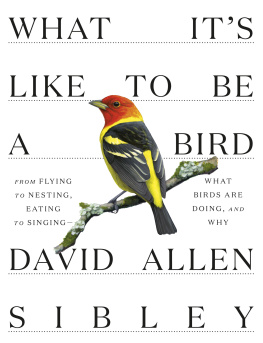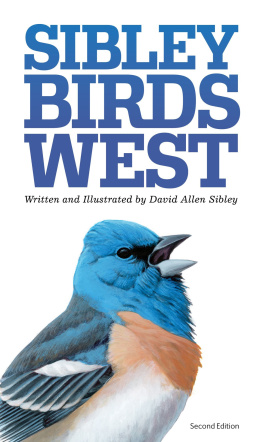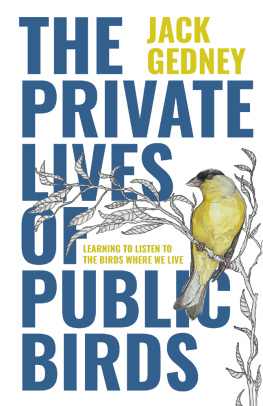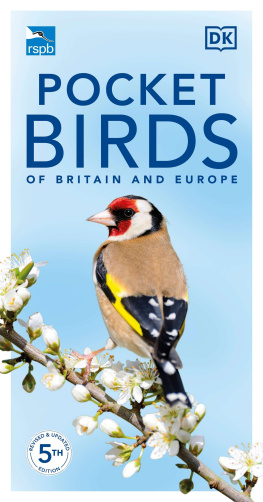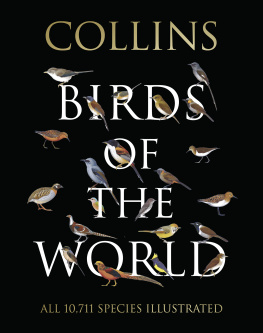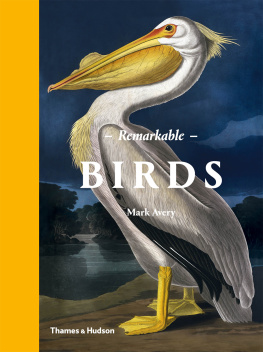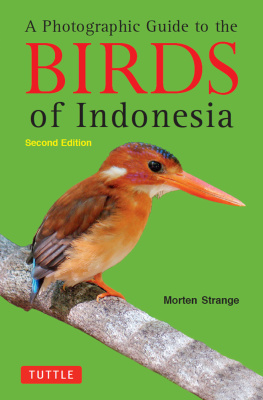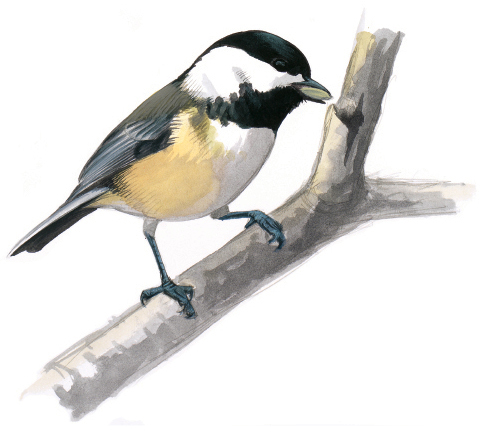Contents
Landmarks
Print Page List
Acknowledgments
This book relies heavily on the constantly growing body of published scientific research, and it would not have been possible without the curiosity and dedication of all of the people who work to advance our knowledge of birds and the natural world. Some of those people are listed as authors of the papers in the Sources section. Many thousands of others have also contributed to our current understanding of birds through those studies and countless more. I owe thanks to them all.
Thanks to the following people who helped directly with this book by answering questions, providing references, reading drafts, etc: Kate Davis, Lorna Gibson, Jerry Liguori, Klara Nordern, Danny Price, Jeff Podos, Richard Prum, Peter Pyle, J. Michael Reed, Marj Rines, Margaret Rubega, Mary Stoddard, Luke Tyrrell, and Joan Walsh.
Special thanks to these three people who put in extra time with research help, reading, rereading, and general consulting at various stages of the project: Chris Elphick, Lindall Kidd, and Tooey Rogers.
Thanks to my agent, Russell Galen, for being excellent at his job, so I could focus on mine.
Thanks to the publishing team at Alfred A. Knopf for their patience as this project slowly developed, and then for expertly weaving it all together into a real book.
Thanks to my wife, Joan, and my sons, Evan and Joel, for making sure I had just enough time to get this done.
Also by David Allen Sibley
The Sibley Guide to Birds
The Sibley Field Guide to Birds of Eastern North America
The Sibley Field Guide to Birds of Western North America
The Sibley Guide to Bird Life and Behavior
The Sibley Guide to Trees
Sibleys Birding Basics
ABOUT THE AUTHOR
David Allen Sibley is the author and illustrator of the series of successful guides to nature that bear his name, including The Sibley Guide to Birds . He has contributed to Smithsonian , Science , The Wilson Journal of Ornithology , Birding , BirdWatching , and North American Birds , as well as to The New York Times . He is the recipient of the Roger Tory Peterson Award for Lifetime Achievement from the American Birding Association and the Linnaean Society of New Yorks Eisenmann Medal.
Sources
The sources listed for each essay in the following pages are specific and technical references. A few general sources were also critical to the research for this book. These provided useful information for many of the essays, and make a good starting point for further reading:
Gill et al 2019. Ornithology . 4th ed. New York: W. H. Freeman.
Scanes, ed. 2014. Sturkies Avian Physiology . 6th ed. Cambridge, MA: Academic Press.
Proctor and Lynch 1998. Manual of Ornithology: Avian Structure and Function . New Haven: Yale University Press.
Rodewald, ed. 2015. The Birds of North America . Cornell Laboratory of Ornithology, Ithaca, NY. https://birdsna.org
:
Starck and Ricklefs 1998. Patterns of Development: The Altricial-Precocial Spectrum. In J. M. Starck and R. E. Ricklefs, eds., Avian Growth and Development . Evolution Within the Altricial Precocial Spectrum . New York: Oxford University Press.
:
Lorenz 1952. King Solomons Ring . New York: Methuen.
Hess 1958. Imprinting in animals. Scientific American 198: 8190.
:
Caithamer et al 1993. Field identification of age and sex of interior Canada geese. Wildlife Society Bulletin 21: 480487.
:
Portugal et al 2014. Upwash exploitation and downwash avoidance by flap phasing in ibis formation flight. Nature 505: 399402.
Weimerskirch et al 2001. Energy saving in flight formation. Nature 413: 697698.
:
Howell 2010. Molt in North American Birds . New York: Houghton Mifflin Harcourt.
Gates et al 1993. The annual molt cycle of Branta canadensis interior in relation to nutrient reserve dynamics. The Condor 95: 680693.
Tonra and Reudink 2018. Expanding the traditional definition of molt-migration. The Auk 135: 11231132.
:
Gionfriddo and Best 1999. Grit use by birds. In V. Nolan, E. D. Ketterson, C. F. Thompson, eds., Current Ornithology , Volume 15 . Boston: Springer.
:
Ammann 1937. Number of contour feathers of Cygnus and Xanthocephalus.
The Auk 54: 201202.
:
Hanson 2011. Feathers . New York: Basic Books.
:
Queeny 1947. Prairie Wings: Pen and Camera Flight Studies . New York: Lippincott.
:
Wang and Meyers 2016. Light like a feather: a fibrous natural composite with a shape changing from round to square. Advanced Science 4: 1600360.
:
Bailey et al 2015. Birds build camouflaged nests. The Auk 132: 1115.
:
Kirby and Cowardin 1986. Spring and summer survival of female Mallards from north central Minnesota. Journal of Wildlife Management 50: 3843.
Arnold et al 2012. Costs of reproduction in breeding female Mallards: predation risk during incubation drives annual mortality. Avian Conservation and Ecology 7(1): 1.
:
Midtgard 1981. The rete tibiotarsale and arteriovenous association in the hind limb of birds: a comparative morphological study on counter-current heat exchange systems. Acta Zoologica 62: 6787.
Midtgard 1989. Circulatory adaptations to cold in birds. In C. Bech, R. E. Reinertsen, eds., Physiology of Cold Adaptation in Birds . NATO ASI Series (Series A: Life Sciences), vol. 173. Boston: Springer.
Kilgore and Schmidt-Nielsen 1975. Heat loss from ducks feet immersed in cold water. The Condor 77: 475517.
:
Prum 2017. The Evolution of Beauty: How Darwins Forgotten Theory of Mate Choice Shapes the Animal Worldand Us . New York: Doubleday.
:
Chen et al 2015. Development, regeneration, and evolution of feathers. Annual Review of Animal Bioscience 3: 169195.
:
Bokenes and Mercer 1995. Salt gland function in the common eider duck ( Somateria mollissima ). Journal of Comparative Physiology B 165: 255267.
:
Rijke and Jesser 2011. The water penetration and repellency of feathers revisited. The Condor 113: 245254.
Srinivasan et al 2014. Quantification of feather structure, wettability and resistance to liquid penetration. Journal of the Royal Society Interface 11.
Bormashenko et al 2007. Why do pigeon feathers repel water? Hydrophobicity of pennae, Cassie-Baxter wetting hypothesis and Cassie-Wenzel capillarity-induced wetting transition. Journal of Colloid and Interface Science 311: 212216.
:
Rowland et al 2015. Comparative Taste Biology with Special Focus on Birds and Reptiles. In R. L. Doty, ed., Handbook of Olfaction and Gustation , 3rd ed. New York: Wiley-Liss.
Clark et al 2014. The Chemical Senses in Birds. In C. Scanes, ed., Sturkies Avian Physiology . Cambridge: Academic Press.
Wang and Zhao 2015. Birds generally carry a small repertoire of bitter taste receptor genes. Genome Biology and Evolution 7: 27052715.
Skelhorn and Rowe 2010. Birds learn to use distastefulness as a signal of toxicity. Proceedings of the Royal Society B: Biological Sciences 277.
:
Evers et al 2010. Common Loon ( Gavia immer ). Version 2.0. In A. F. Poole, ed., The Birds of North America . Ithaca: Cornell Lab of Ornithology.
:
Roberts et al 2013. Population fluctuations and distribution of staging Eared Grebes ( Podiceps nigricollis ) in North America. Canadian Journal of Zoology 91: 906913.
Jehl et al 2003. Optimizing Migration in a Reluctant and Inefficient Flier: The Eared Grebe. In P. Berthold, E. Gwinner, E. Sonnenschein, eds., Avian Migration . Springer Berlin / Heidelberg.

